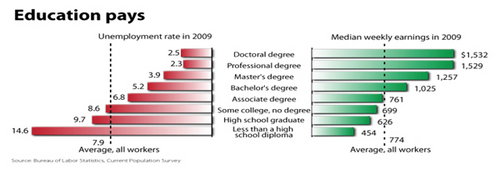It is not unusual for the public to wake up to live television footage of student protestors in Islamabad, Athens, Caracas, Jakarta or Cairo waving red banners, smashing windows, breaking into buildings and then starting fires. However, this morning, the city was London and the protestors were British students burning books. The press is reporting that the students are angry over an expected doubling of the cost of higher education tuition next year. I believe the protests are associated with the rising angst of young people in the developed world who believe their economic well-being is in permanent decline.
When most public policy “experts” talk about structural unemployment, it is assumed they are referring to the under privileged in depressed intercity and rural communities. The high school dropout rate in these forlorn populations continues is twice suburban rate and their standardized test scores are approximately 20% lower. Consequently, only the most gifted students in these societies can expect to go on to the hoped for permanent lifestyle improvement of a college education.
As shown in the U.S. Department of Labor graphs above for the year 2009, 25 and older workers with a high school diploma make 40% more than a drop-out and those with four year college degrees make over 50% more than a high school graduate. Consequently, there has been a tremendous push to try to lift Americans out of poverty through a college education.
What the graphs above conveniently ignore is that unemployment for college-educated 20-24 year-olds is currently 9.6 percent, virtually identical to the national average. In December of 2007, before the Great Recession started, the rate for 20-24 year old college graduates was 3.4 percent. This 282% increase in unemployment for recent college graduates is the largest percentage increase among all education and age groups. Furthermore, the unemployment rate for college educated 20-24 year-olds does not include the graduates who are employed part-time, which is at a 17.5% rate.
The American Recovery and Reinvestment Act of 2009 passed by Congress in February of last year has been a bust for the recent college graduates. The stimulus was sold as a $787 million economic stimulus to create jobs, promote investment and encourage consumer spending. Instead, private sector borrowing has been crowded out a massive issuance of government debt and the unemployment rate continued to rise. Although 20-24 year-olds usually do not care much about healthcare believe they believe they will live forever, employers have dramatically cut back on hiring and training of recent college graduates because of increased future benefit costs.
Given the difficult employment market, students have tended to try to stay in school until times improve. There are only 2.3 million higher education students in the United Kingdom, but the United States currently has and 17.5 million full-time college students.
As demonstrated by the graph above, the cost of education since 1978 has been rising three times faster than the consumer price index. With states running gigantic deficits and the stimulus money petering out, America’s state supported colleges and universities will have to either cut back enrollment and staffing or raise tuition substantially. With recent college graduates and current students facing depressed employment opportunities and higher fees, do not be surprised that the next student protestors waving red banners, smashing windows, breaking into buildings and starting fires are at a college campus near you.


COMMENTS
Please let us know if you're having issues with commenting.